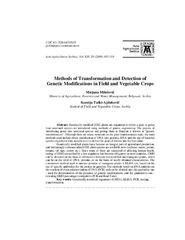Приказ основних података о документу
Methods of transformation and detection of genetic modifications in field and vegetable crops
Metode transformacije i određivanja genetičkih modifikacija kod ratarskih i povrtarskih biljaka
| dc.creator | Milošević, Mirjana | |
| dc.creator | Taški-Ajduković, Ksenija | |
| dc.date.accessioned | 2021-04-26T18:30:00Z | |
| dc.date.available | 2021-04-26T18:30:00Z | |
| dc.date.issued | 2009 | |
| dc.identifier.issn | 0354-9542 | |
| dc.identifier.uri | http://fiver.ifvcns.rs/handle/123456789/692 | |
| dc.description.abstract | Genetically modified (GM) plants are organisms to which a gene or genes from unrelated species are introduced using methods of genetic engineering. The process of introducing genes into unrelated species and getting them to function is known as 'genetic transformation'. Although there are many variations on the plant transformation topic, the main methods used include direct introduction of DNA into genomic DNA and the use of bacterial species (Agrobacterium tumefaciens) to deliver the gene of interest into the host plant. Genetically modified plants have become an integral part of agricultural production, and increasingly commercialized GM plant species are available now (soybean, maize, potato, tomato, oil rape, cotton etc.). Since some of them are suspected of affecting human health, testing of GMO prescribed by a law regulative has become obligatory in most countries. GMO can be detected on the basis of differences between non-modified and transgenic plants, which can be on the level of DNA, proteins, or on the basis of newly obtained characteristics. The commonest method used to analyze proteins of transgenic plants is ELISA test, based on the use of specific antibodies for the protein in question. The methods based on DNA analysis use the reaction of chain polymerization of DNA (PCR) and can be divided into: the qualitative one - used for determination of the presence of genetic modifications, and the quantitative one - revealing GMO percentage (competitive PCR and Real Time). | en |
| dc.description.abstract | Genetički modifikovani organizmi (GMO) su organizmi u koje je unesen gen ili geni iz nesrodnih vrsta metodama genetičkog inženjeringa (transformacije). Postroje različite metode tranformacija. Najveći broj GM biljaka nastao je direktnim unošenjem dela DNK u genom (direktne transformacije) ili pomoću bakterije Agrobacterium tumefaciens, koja ima sposobnost prenosa DNK u biljnu ćeliju (transformacija putem Agrobakterijuma). Genetski modifikovane biljke su postale sastavni deo poljoprivredne proizvodnje i sve je više GM biljnih vrsta koje su komercijalno dostupne (soja, kukuruz, krompir, paradajz, uljana repica i dr.). Kako je dokazano da neke od njih mogu uticati na ljudsko zdravlje u većini zemalja je obaveza testiranja GMO propisana zakonskom regulativom. GMO se mogu detektovati na osnovu razlika između nemodifikovane i transgene biljke, koje mogu biti na nivou DNK, proteina ili na osnovu novostečene karakteristike. Najčešće korišćena metoda za analizu proteina transgenih biljaka je ELISA test koji se zasniva na korišćenju specifičnih antitela za protein od interesa. Metode zasnovane na analizi DNK su bazirane na reakciji lančane polimerizacije DNK (PCR) i mogu se podeliti na: kvalitativne, kojima se određuje da li su prisustvo genetske modifikacije i kvantitivne, koje pokazuju procenat GMO (kompetitivni PCR i Real Time). | sr |
| dc.publisher | Univerzitet u Kragujevcu - Agronomski fakultet, Čačak | |
| dc.rights | openAccess | |
| dc.rights.uri | https://creativecommons.org/licenses/by/4.0/ | |
| dc.source | Acta agriculturae Serbica | |
| dc.subject | genetically modified organisms (GMOs) | en |
| dc.subject | ELISA | en |
| dc.subject | PCR | en |
| dc.subject | testing | en |
| dc.subject | transformation | en |
| dc.title | Methods of transformation and detection of genetic modifications in field and vegetable crops | en |
| dc.title | Metode transformacije i određivanja genetičkih modifikacija kod ratarskih i povrtarskih biljaka | sr |
| dc.type | article | |
| dc.rights.license | BY | |
| dc.citation.epage | 110 | |
| dc.citation.issue | 28 | |
| dc.citation.other | 14(28): 101-110 | |
| dc.citation.rank | M52 | |
| dc.citation.spage | 101 | |
| dc.citation.volume | 14 | |
| dc.identifier.fulltext | http://fiver.ifvcns.rs/bitstream/id/1537/689.pdf | |
| dc.identifier.rcub | https://hdl.handle.net/21.15107/rcub_fiver_692 | |
| dc.type.version | publishedVersion |


